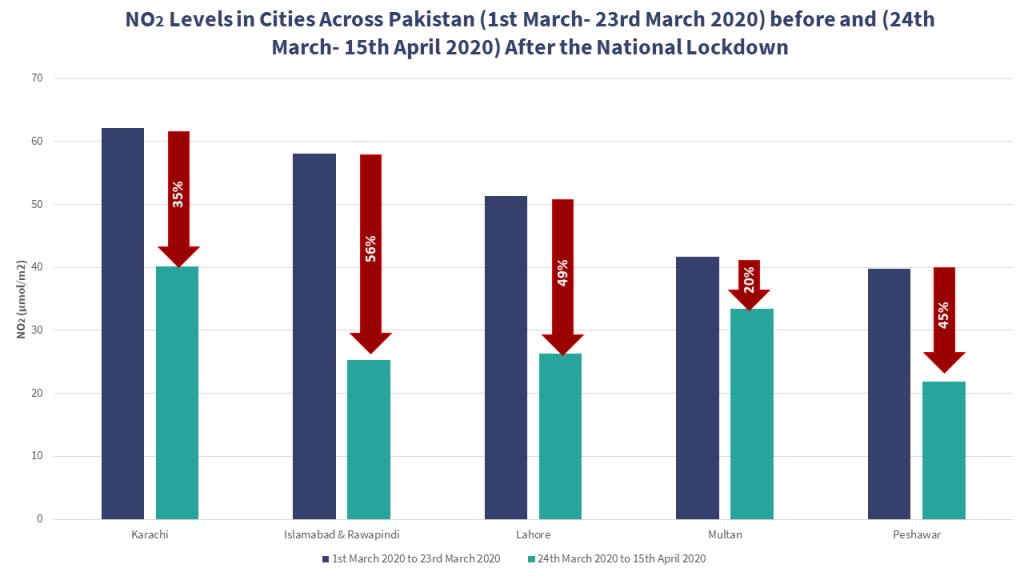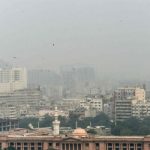Coronavirus outbreak has forced nations under lockdowns restricting or putting a halt on transportation, agricultural as well as industrial activities across the globe. These measures are taken in order to contain the pandemic and save lives.
Many necessary services have been halted leading to increasing discomfort to the populations, loss of jobs and work leading to economic difficulties for communities are other harsh realities which we face today due to the global pandemic of Covid19. In Pakistan more than 9000 people have been infected and at least 192 have lost their lives till 21st April 2020.
Amid all the depressing news and sad times we face globally, there are aspects to reflect upon, especially on the environment and pollution. Air quality levels across the South Asian region are the worst, with Bangladesh, Pakistan and India making it to the top five in the list of most polluted countries as mentioned in 2019 World Air Quality Report by IQAir.
But over past weeks the air quality improvements have come as a by-product of the lockdowns due to coronavirus outbreak across the globe, this sheds lights on some aspects on the issue of environment and pollution which otherwise gets hardly any serious attention in the larger scheme of things. Air pollution levels across geographies have reduced considerably due to reduced fossil fuel consumption in transportation, industries and power plants along with reduction in other sources of pollution.
Real time ambient air quality data availability is very scarce in Pakistan and in absence of such data sets, it becomes very difficult for the policy makers, media, civil society organisation and general public to understand the impact of certain policy decisions or interventions on air quality levels and public health.
Luckily, with advancements in remote sensing and satellite data acquisition as well as advancement of the technology it has become convenient for researchers and analysts to assess prevailing pollution levels in areas with or without much ground pollution monitoring data being made available in public domain.
Last few weeks data for Pakistan has shown that the lockdown in Pakistan has resulted in a drastic drop in pollution level in many cities across the country.

Figure 1: Approx. reductions in NO2 levels across key cities in Pakistan before (1st March- 23rd March 2020) and after (24th March- 15th April 2020) the national lockdown announcement(TROPOMI Sentinel-5P satellite)
Here are some maps plotted using TROPOMI- Sentinel-5P satellite data showing drop in NO2 levels across cities in Pakistan for 23 days before and during the national lockdown. National lockdown started on 24th March 2020 in Pakistan.

Figure 2: Map showing NO2 reductions over Peshawar before (1st March- 23rd March 2020) and after (24th March- 15th April 2020) the national lockdown announcement

Figure 3: Map showing NO2 reductions over Lahore before (1st March- 23rd March 2020) and after (24th March- 15th April 2020) the national lockdown announcement

Figure 4: Map showing NO2 reductions over Multan before (1st March- 23rd March 2020) and after (24th March- 15th April 2020) the national lockdown announcement

Figure 5: Map showing NO2 reductions over Karachi before (1st March- 23rd March 2020) and after (24th March- 15th April 2020) the national lockdown announcement

Figure 6: Map showing NO2 reductions over Islamabad and Rawalpindi before (1st March- 23rd March 2020) and after (24th March- 15th April 2020) the national lockdown announcement
NO2 primarily gets in the air from the burning of fuel and mainly formed by emissions from cars, trucks and buses, power plants, and off-road equipment. Most of these activities being absent/reduced due to nationwide lockdown, the emissions have gone down drastically.
Two NO2 hotspots which were visible before the lockdown around Lahore in areas like Lahore-Sheikhupura road (North-West of Lahore) and Raiwind to Pattoki belt (South of Lahore) with clusters of oil based power plants have reduced considerably indicating decrease in operations. Similarly, for Karachi the satellite data indicates that there were significant reductions in emissions but areas around Korangi-Landhi industrial areas as well as around fertilizer and cement plants at Bin Qasim port still appear to be hotspots for NO2 emissions indicating that some of these facilities were still in operation during the lockdown.
Another reason for the marginal changes in NO2 emissions is the sudden drop in urban traffic, which by some estimates declined as much as 65% across Pakistan. Using anonymised geolocation data, Google estimates that Pakistanis under the lockdown largely stayed away from businesses, parks, shopping centers and workplaces. Poor fuel quality and increasing vehicle concentration have been blamed as the primary cause of poor air quality in Pakistan, and the drastic decrease in vehicular mobility has cut down a major proportion of urban emissions.
NO2 is a dangerous pollutant, responsible for an estimated 120,000 new cases of child asthma and 4,000 premature deaths per year in Pakistan. It is also a key contributor to PM2.5 formation.
The graphs and maps above show that the pollution problem can be tackled and clean skies and breathable air is achievable in Pakistan. Although the current situation and restrictions are not recommended as a way to clean the air which brings huge suffering to the citizens of the country. But these testing times have at-least made us realise and get a sense of how clear skies look like and at the same time have given us hope that we can have breathable clean air if we act concretely to reduce pollution at source.
The ongoing lockdown helping clean the air also shows that the linkage of air pollution levels in South Asian region are very strongly associated with bigger economic activities (Transportation, energy production and industrial activities) along with small scale interventions at city levels. This tells us that in order to avoid pollution levels bouncing back as the economy turns a corner and the coronavirus crisis passes, a shift from the current highly fossil fuel dependent economy to clean energy based systems has to be adopted. Moving forward we will need to
- Adopt state of the art more efficient pollution/emission control technologies for the industries, power generation facilities and transport vehicles to reduce their emission load and pollution.
- Fast-track deployment of new Hydro-cracking refineries as well as installation of Diesel Hydro-desulphurisation (DHDS) units in existing local refineries to move towards Low Sulphur fuels, while renegotiating import contracts to opt for cleaner Euro-6 gasoline and diesel.
- Switch our transportation system from being biased towards promoting privatised modes of transportation to better public transportation facilities and systems.
- Develop Non-Motorised-Transportation (NMT) systems such as walking and cycling as modes for movement for citizens rather than vehicles. And,
- Invest aggressively in cleaner and renewable energy sources.





